2014 MERCEDES-BENZ GL warning
[x] Cancel search: warningPage 422 of 462
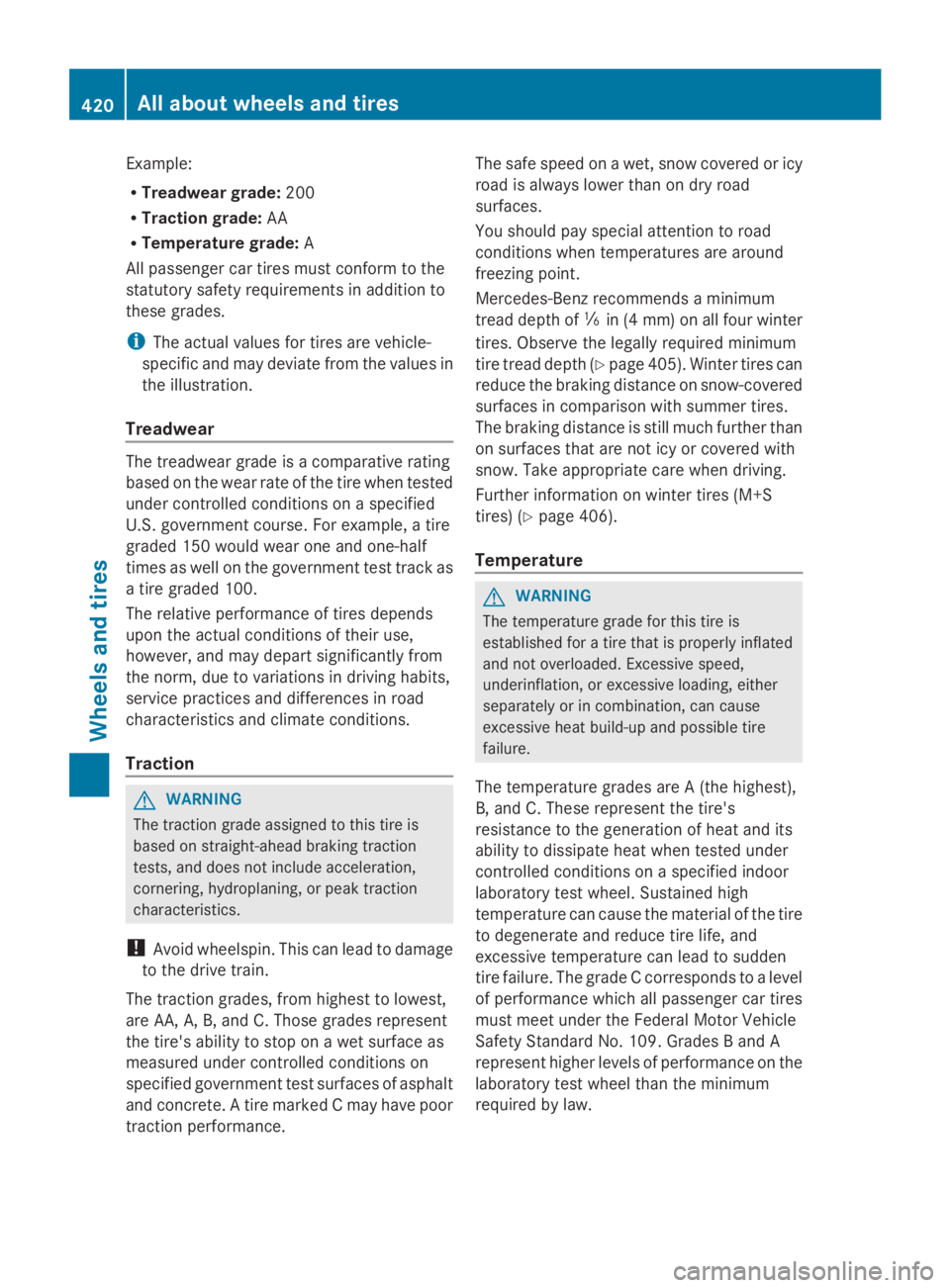
Example:
RTreadwear grade:200
RTraction grade:AA
RTemperature grade:A
All passenger car tires must conform to the
statutory safety requirements in addition to
these grades.
iThe actual values for tires are vehicle-
specific and may deviate from the values in
the illustration.
Treadwear
The treadwear grade is a comparative rating
based on the wear rate of the tire when tested
under controlled conditions on a specified
U.S. government course. For example, a tire
graded 150 would wear one and one-half
times as well on the government test track as
a tire graded 100.
The relative performance of tires depends
upon the actual conditions of their use,
however, and may depart significantly from
the norm, due to variations in driving habits,
service practices and differences in road
characteristics and climate conditions.
Traction
GWARNING
The traction grade assigned to this tire is
based on straight-ahead braking traction
tests, and does not include acceleration,
cornering, hydroplaning, or peak traction
characteristics.
!Avoid wheelspin. This can lead to damage
to the drive train.
The traction grades, from highest to lowest,
are AA, A, B, and C. Those grades represent
the tire's ability to stop on a wet surface as
measured under controlled conditions on
specified government test surfaces of asphalt
and concrete. A tire marked C may have poor
traction performance.
The safe speed on a wet, snow covered or icy
road is always lower than on dry road
surfaces.
You should pay special attention to road
conditions when temperatures are around
freezing point.
Mercedes-Benz recommends a minimum
tread depth of�
Page 430 of 462
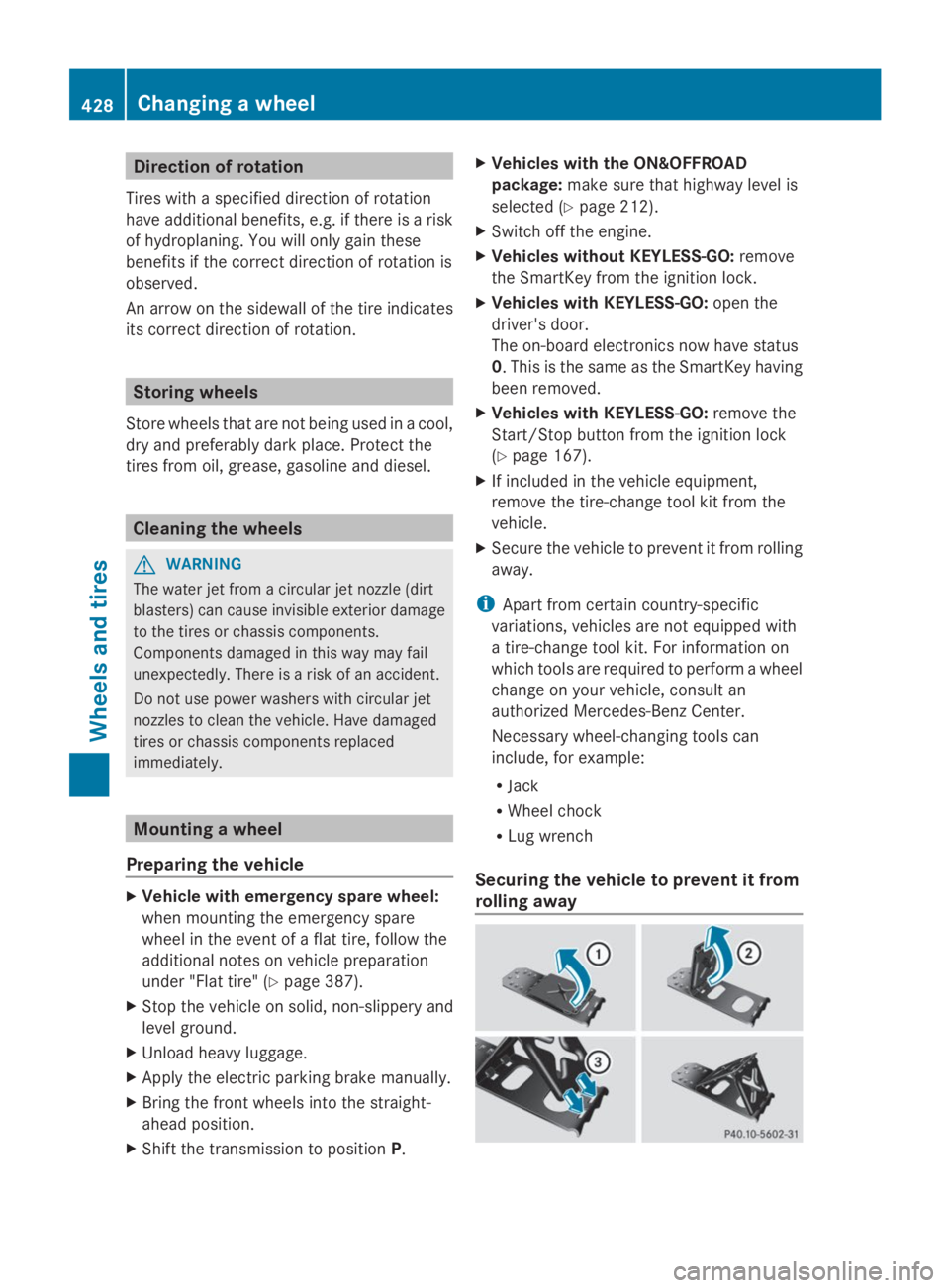
Direction of rotation
Tires with a specified direction of rotation
have additional benefits, e.g. if there is a risk
of hydroplaning. You will only gain these
benefits if the correct direction of rotation is
observed.
An arrow on the sidewall of the tire indicates
its correct direction of rotation.
Storing wheels
Store wheels that are not being used in a cool,
dry and preferably dark place. Protect the
tires from oil, grease, gasoline and diesel.
Cleaning the wheels
GWARNING
The water jet from a circular jet nozzle (dirt
blasters) can cause invisible exterior damage
to the tires or chassis components.
Components damaged in this way may fail
unexpectedly. There is a risk of an accident.
Do not use power washers with circular jet
nozzles to clean the vehicle. Have damaged
tires or chassis components replaced
immediately.
Mounting a wheel
Preparing the vehicle
XVehicle with emergency spare wheel:
when mounting the emergency spare
wheel in the event of a flat tire, follow the
additional notes on vehicle preparation
under "Flat tire" (Ypage 387).
XStop the vehicle on solid, non-slippery and
level ground.
XUnload heavy luggage.
XApply the electric parking brake manually.
XBring the front wheels into the straight-
ahead position.
XShift the transmission to positionP.
XVehicles with the ON&OFFROAD
package:make sure that highway level is
selected (Ypage 212).
XSwitch off the engine.
XVehicles without KEYLESS-GO:remove
the SmartKey from the ignition lock.
XVehicles with KEYLESS-GO:open the
driver's door.
The on-board electronics now have status
0. This is the same as the SmartKey having
been removed.
XVehicles with KEYLESS-GO:remove the
Start/Stop button from the ignition lock
(Ypage 167).
XIf included in the vehicle equipment,
remove the tire-change tool kit from the
vehicle.
XSecure the vehicle to prevent it from rolling
away.
iApart from certain country-specific
variations, vehicles are not equipped with
a tire-change tool kit. For information on
which tools are required to perform a wheel
change on your vehicle, consult an
authorized Mercedes-Benz Center.
Necessary wheel-changing tools can
include, for example:
RJack
RWheel chock
RLug wrench
Securing the vehicle to prevent it from
rolling away
428Changing a wheel
Wheels and tires
Page 434 of 462
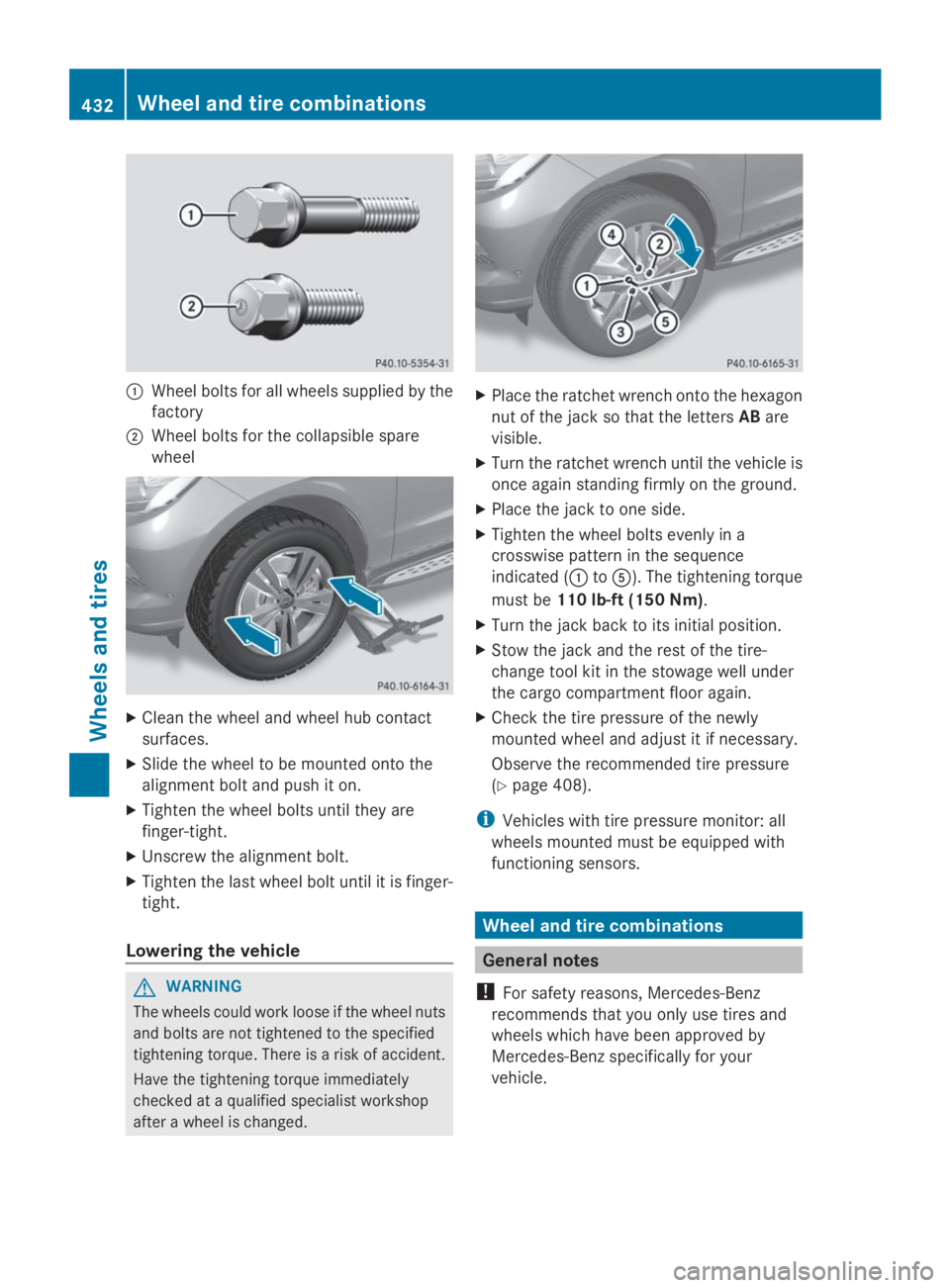
�CWheel bolts for all wheels supplied by the
factory
�DWheel bolts for the collapsible spare
wheel
XClean the wheel and wheel hub contact
surfaces.
XSlide the wheel to be mounted onto the
alignment bolt and push it on.
XTighten the wheel bolts until they are
finger-tight.
XUnscrew the alignment bolt.
XTighten the last wheel bolt until it is finger-
tight.
Lowering the vehicle
GWARNING
The wheels could work loose if the wheel nuts
and bolts are not tightened to the specified
tightening torque. There is a risk of accident.
Have the tightening torque immediately
checked at a qualified specialist workshop
after a wheel is changed.
XPlace the ratchet wrench onto the hexagon
nut of the jack so that the lettersABare
visible.
XTurn the ratchet wrench until the vehicle is
once again standing firmly on the ground.
XPlace the jack to one side.
XTighten the wheel bolts evenly in a
crosswise pattern in the sequence
indicated (�Cto�
Page 437 of 462
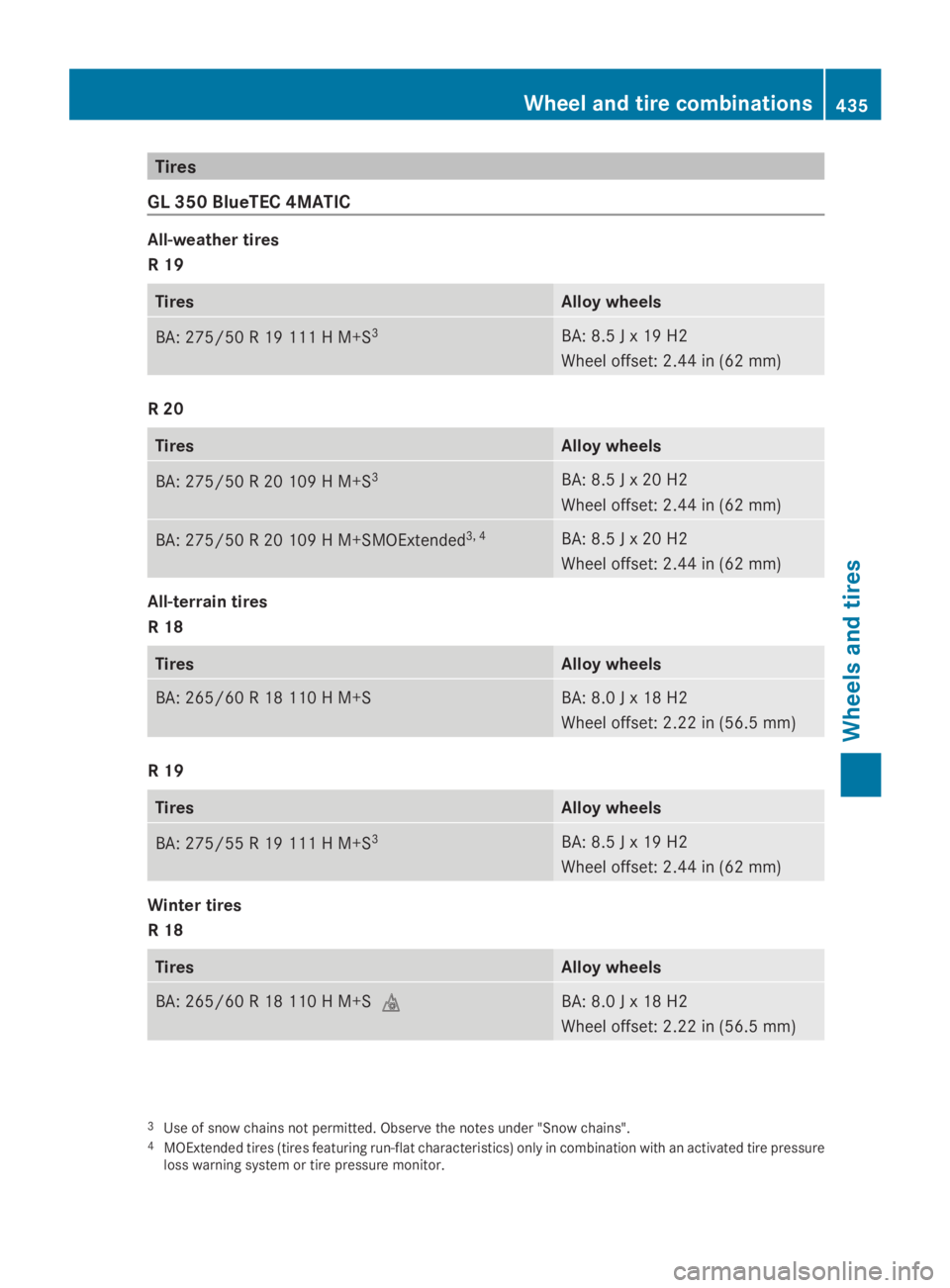
Tires
GL 350 BlueTEC 4MATIC
All-weather tires
R 19
TiresAlloy wheels
BA: 275/50 R 19 111H M+S3BA: 8.5 J x 19 H2
Wheel offset: 2.44 in (62 mm)
R 20
TiresAlloy wheels
BA: 275/50 R 20 109 H M+S3BA: 8.5 J x 20 H2
Wheel offset: 2.44 in (62 mm)
BA: 275/50 R 20 109 H M+SMOExtended3, 4BA: 8.5 J x 20 H2
Wheel offset: 2.44 in (62 mm)
All-terrain tires
R 18
TiresAlloy wheels
BA: 265/60 R 18 110 H M+SBA: 8.0 J x 18 H2
Wheel offset: 2.22 in (56.5 mm)
R 19
TiresAlloy wheels
BA: 275/55 R 19 111 H M+S3BA: 8.5 J x 19 H2
Wheel offset: 2.44 in (62 mm)
Winter tires
R 18
TiresAlloy wheels
BA: 265/60 R 18 110 H M+S�MBA: 8.0 J x 18 H2
Wheel offset: 2.22 in (56.5 mm)
3Use of snow chains not permitted. Observe the notes under "Snow chains".4MOExtended tires (tires featuring run-flat characteristics) only in combination with an activated tire pressureloss warning system or tire pressure monitor.
Wheel and tire combinations435
Wheels and tires
Z
Page 438 of 462
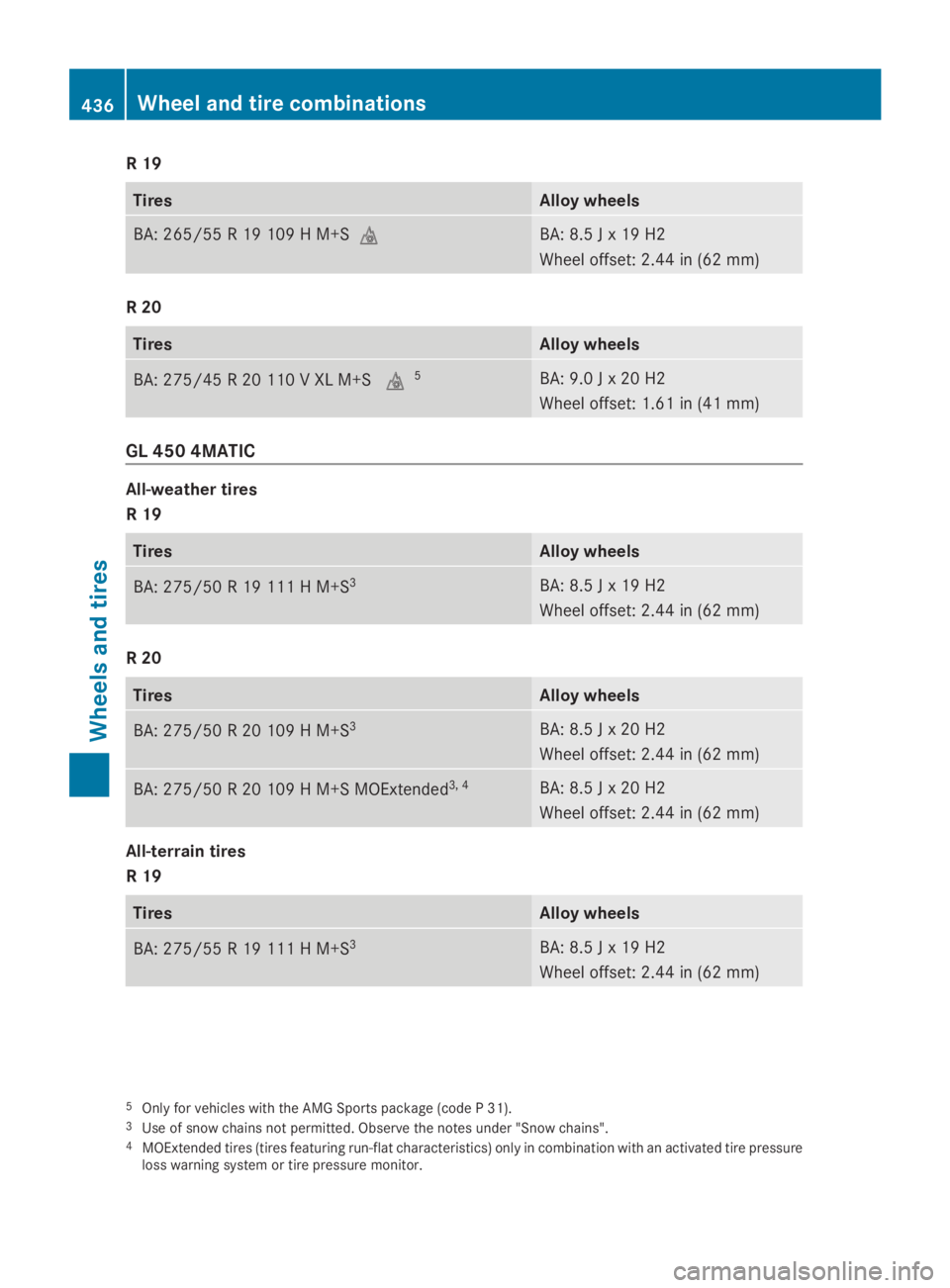
R 19
TiresAlloy wheels
BA: 265/55 R 19 109 H M+S�MBA: 8.5 J x 19 H2
Wheel offset: 2.44 in (62 mm)
R 20
TiresAlloy wheels
BA: 275/45 R 20 110 V XL M+S�M5BA: 9.0 J x 20 H2
Wheel offset: 1.61 in (41 mm)
GL 450 4MATIC
All-weather tires
R 19
TiresAlloy wheels
BA: 275/50 R 19 111 H M+S3BA: 8.5 J x 19 H2
Wheel offset: 2.44 in (62 mm)
R 20
TiresAlloy wheels
BA: 275/50 R 20 109 H M+S3BA: 8.5 J x 20 H2
Wheel offset: 2.44 in (62 mm)
BA: 275/50 R 20 109 H M+S MOExtended3, 4BA: 8.5 J x 20 H2
Wheel offset: 2.44 in (62 mm)
All-terrain tires
R 19
TiresAlloy wheels
BA: 275/55 R 19 111 H M+S3BA: 8.5 J x 19 H2
Wheel offset: 2.44 in (62 mm)
5Only for vehicles with the AMG Sports package (code P 31).3Use of snow chains not permitted. Observe the notes under "Snow chains".4MOExtended tires (tires featuring run-flat characteristics) only in combination with an activated tire pressureloss warning system or tire pressure monitor.
436Wheel and tire combinations
Wheels and tires
Page 439 of 462
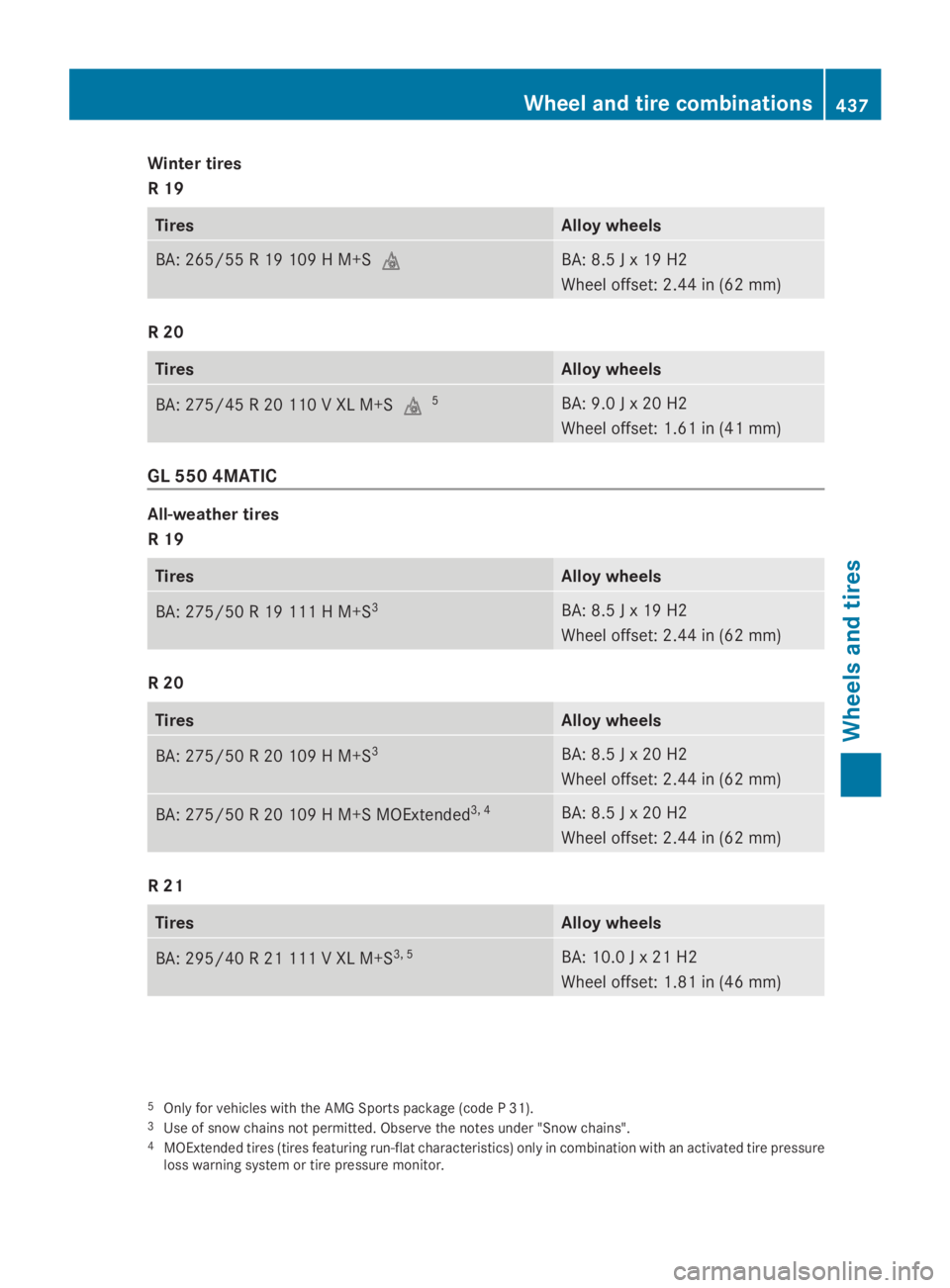
Winter tires
R 19
TiresAlloy wheels
BA: 265/55 R 19 109 H M+S�MBA: 8.5 J x 19 H2
Wheel offset: 2.44 in (62 mm)
R 20
TiresAlloy wheels
BA: 275/45 R 20 110 V XL M+S�M5BA: 9.0 J x 20 H2
Wheel offset: 1.61 in (41 mm)
GL 550 4MATIC
All-weather tires
R 19
TiresAlloy wheels
BA: 275/50 R 19 111 H M+S3BA: 8.5 J x 19 H2
Wheel offset: 2.44 in (62 mm)
R 20
TiresAlloy wheels
BA: 275/50 R 20 109 H M+S3BA: 8.5 J x 20 H2
Wheel offset: 2.44 in (62 mm)
BA: 275/50 R 20 109 H M+S MOExtended3, 4BA: 8.5 J x 20 H2
Wheel offset: 2.44 in (62 mm)
R 21
TiresAlloy wheels
BA: 295/40 R 21 111 V XL M+S3, 5BA: 10.0 J x 21 H2
Wheel offset: 1.81 in (46 mm)
5Only for vehicles with the AMG Sports package (code P 31).3Use of snow chains not permitted. Observe the notes under "Snow chains".4MOExtended tires (tires featuring run-flat characteristics) only in combination with an activated tire pressureloss warning system or tire pressure monitor.
Wheel and tire combinations437
Wheels and tires
Z
Page 441 of 462
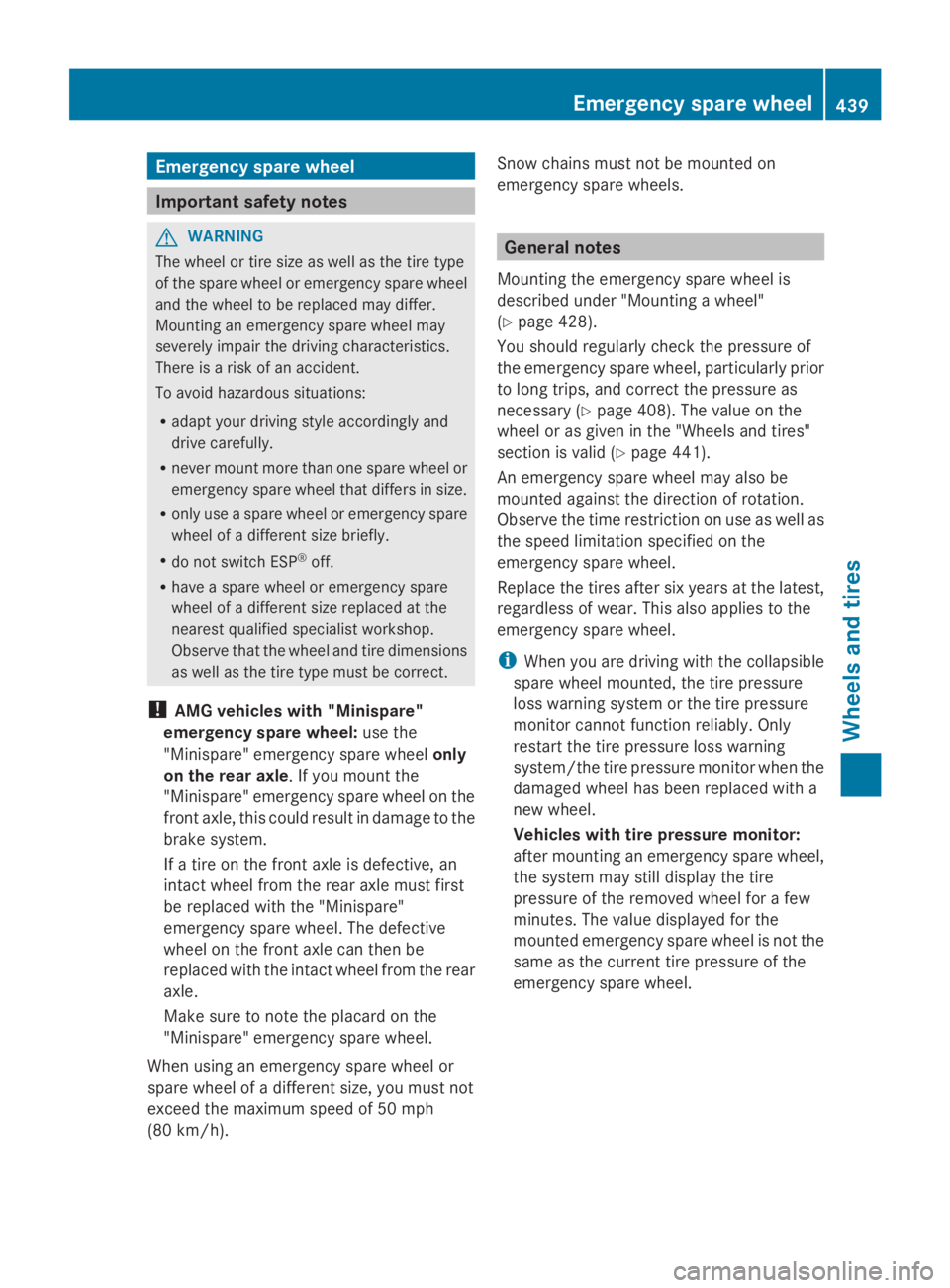
Emergency spare wheel
Important safety notes
GWARNING
The wheel or tire size as well as the tire type
of the spare wheel or emergency spare wheel
and the wheel to be replaced may differ.
Mounting an emergency spare wheel may
severely impair the driving characteristics.
There is a risk of an accident.
To avoid hazardous situations:
Radapt your driving style accordingly and
drive carefully.
Rnever mount more than one spare wheel or
emergency spare wheel that differs in size.
Ronly use a spare wheel or emergency spare
wheel of a different size briefly.
Rdo not switch ESP®off.
Rhave a spare wheel or emergency spare
wheel of a different size replaced at the
nearest qualified specialist workshop.
Observe that the wheel and tire dimensions
as well as the tire type must be correct.
!AMG vehicles with "Minispare"
emergency spare wheel:use the
"Minispare" emergency spare wheelonly
on the rear axle. If you mount the
"Minispare" emergency spare wheel on the
front axle, this could result in damage to the
brake system.
If a tire on the front axle is defective, an
intact wheel from the rear axle must first
be replaced with the "Minispare"
emergency spare wheel. The defective
wheel on the front axle can then be
replaced with the intact wheel from the rear
axle.
Make sure to note the placard on the
"Minispare" emergency spare wheel.
When using an emergency spare wheel or
spare wheel of a different size, you must not
exceed the maximum speed of 50 mph
(80 km/h).
Snow chains must not be mounted on
emergency spare wheels.
General notes
Mounting the emergency spare wheel is
described under "Mounting a wheel"
(Ypage 428).
You should regularly check the pressure of
the emergency spare wheel, particularly prior
to long trips, and correct the pressure as
necessary (Ypage 408). The value on the
wheel or as given in the "Wheels and tires"
section is valid (Ypage 441).
An emergency spare wheel may also be
mounted against the direction of rotation.
Observe the time restriction on use as well as
the speed limitation specified on the
emergency spare wheel.
Replace the tires after six years at the latest,
regardless of wear. This also applies to the
emergency spare wheel.
iWhen you are driving with the collapsible
spare wheel mounted, the tire pressure
loss warning system or the tire pressure
monitor cannot function reliably. Only
restart the tire pressure loss warning
system/the tire pressure monitor when the
damaged wheel has been replaced with a
new wheel.
Vehicles with tire pressure monitor:
after mounting an emergency spare wheel,
the system may still display the tire
pressure of the removed wheel for a few
minutes. The value displayed for the
mounted emergency spare wheel is not the
same as the current tire pressure of the
emergency spare wheel.
Emergency spare wheel439
Wheels and tires
Z
Page 448 of 462
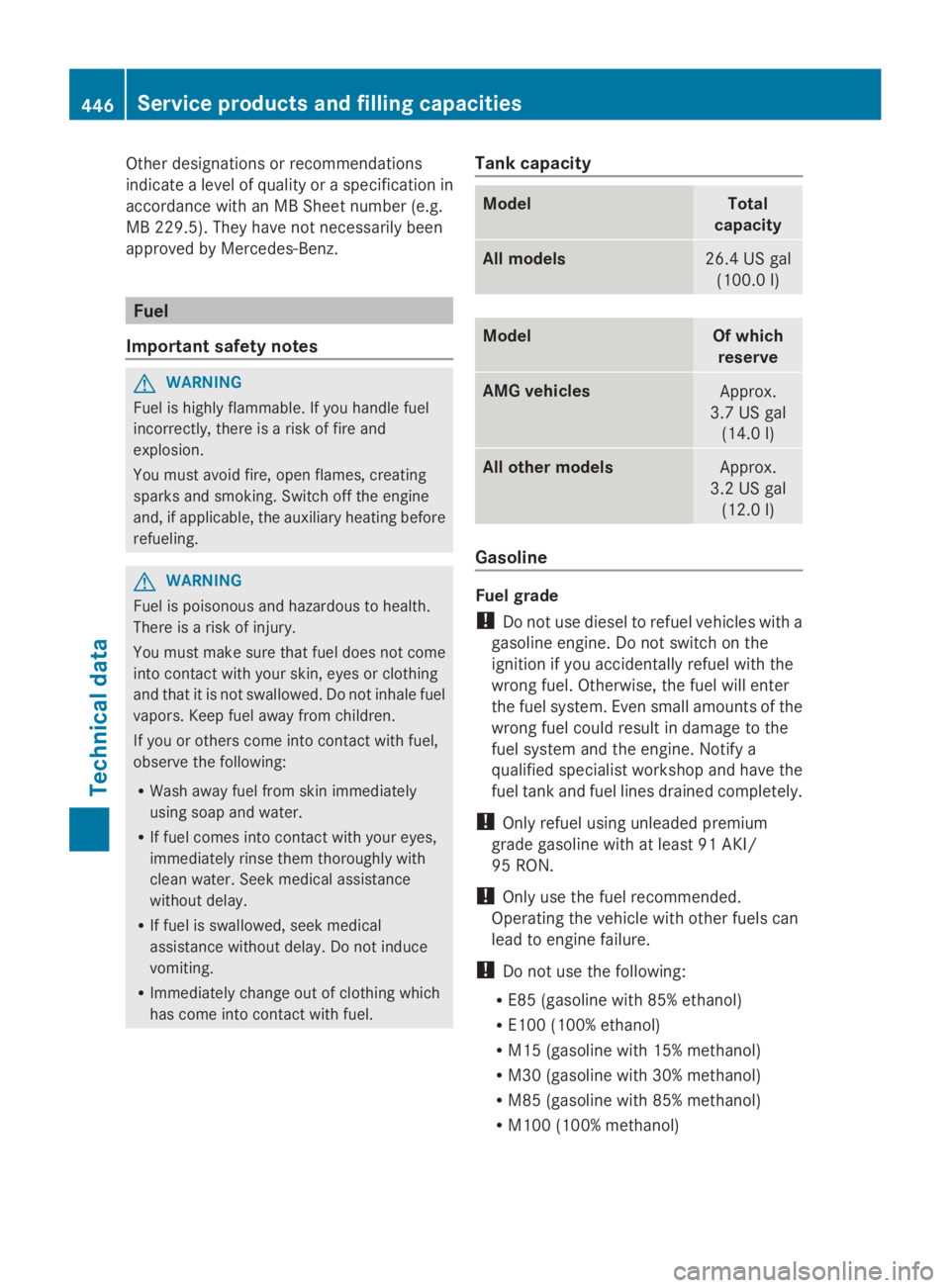
Other designations or recommendations
indicate a level of quality or a specification in
accordance with an MB Sheet number (e.g.
MB 229.5). They have not necessarily been
approved by Mercedes-Benz.
Fuel
Important safety notes
GWARNING
Fuel is highly flammable. If you handle fuel
incorrectly, there is a risk of fire and
explosion.
You must avoid fire, open flames, creating
sparks and smoking. Switch off the engine
and, if applicable, the auxiliary heating before
refueling.
GWARNING
Fuel is poisonous and hazardous to health.
There is a risk of injury.
You must make sure that fuel does not come
into contact with your skin, eyes or clothing
and that it is not swallowed. Do not inhale fuel
vapors. Keep fuel away from children.
If you or others come into contact with fuel,
observe the following:
RWash away fuel from skin immediately
using soap and water.
RIf fuel comes into contact with your eyes,
immediately rinse them thoroughly with
clean water. Seek medical assistance
without delay.
RIf fuel is swallowed, seek medical
assistance without delay. Do not induce
vomiting.
RImmediately change out of clothing which
has come into contact with fuel.
Tank capacity
ModelTotal
capacity
All models26.4 US gal
(100.0 l)
ModelOf which
reserve
AMG vehiclesApprox.
3.7 US gal
(14.0 l)
All other modelsApprox.
3.2 US gal
(12.0 l)
Gasoline
Fuel grade
!Do not use diesel to refuel vehicles with a
gasoline engine. Do not switch on the
ignition if you accidentally refuel with the
wrong fuel. Otherwise, the fuel will enter
the fuel system. Even small amounts of the
wrong fuel could result in damage to the
fuel system and the engine. Notify a
qualified specialist workshop and have the
fuel tank and fuel lines drained completely.
!Only refuel using unleaded premium
grade gasoline with at least 91 AKI/
95 RON.
!Only use the fuel recommended.
Operating the vehicle with other fuels can
lead to engine failure.
!Do not use the following:
RE85 (gasoline with 85% ethanol)
RE100 (100% ethanol)
RM15 (gasoline with 15% methanol)
RM30 (gasoline with 30% methanol)
RM85 (gasoline with 85% methanol)
RM100 (100% methanol)
446Service products and filling capacities
Technical data